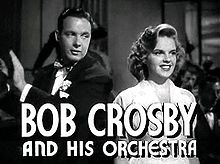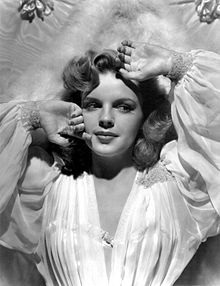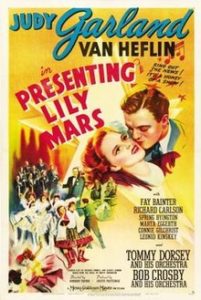Presenting Lily Mars *** (1943, Judy Garland, Van Heflin, Fay Bainter, Richard Carlson, Marta Eggerth, Spring Byington, Bob Crosby, Tommy Dorsey) – Classic Movie Review 5182
Director Norman Taurog’s 1943 musical Presenting Lily Mars comes with the kudos of presenting Judy Garland, aged 19, in a cute and amiable small-time MGM show with an attempt at extra added class, which only proves a few pretensions above its humble station.
Richard Connell and Gladys Lehman’s screenplay is based on the 1937 novel by Booth Tarkington, a property originally earmarked for Lana Turner. It tells the familiar, old (even in 1943) story of a stagestruck Indiana small-town gal desperate to tread the boards on the Broadway stage.
Though he is not Garland’s best ever co-star, Van Heflin has his moments as the New York producer John Thornway, whom Garland’s Lily Mars hounds, until he gives her an understudy job. Soon enough, they fall in love and then the show’s star Isobel Rekay (Marta Eggerth) quits.
Fay Bainter as Mrs Thornway, Richard Carlson as Owen Vail, Spring Byington as Mrs Mars, Bob Crosby and his Orchestra, Tommy Dorsey and his Orchestra, Marilyn Maxwell, Connie Gilchrist as Frankie and Leonid Kinskey as Leo are also in the good cast, along with Patricia Barker as Poppy, Janet Chapman as Violet, Annie Ross as Rosie, Douglas Croft as Davey, Ray McDonald as Charlie Potter and Charles Walters as Lily’s Dance Partner in Final.
But it is Judy’s show all the way and the MGM studio gives her some attractive tunes to sing, like ‘Every Little Movement (Has a Meaning of its Own)’ (Karl Hoschna music, Otto Harbach lyrics), Where There’s Music, Three O’Clock in the Morning and Broadway Rhythm.
Taurog directs amusingly, Ernst Matray is the capable dance director, with the climax staged by choreographer Charles Walters in a different, more extravagant style. Cinematographer Joseph Ruttenberg shoots it nicely, but it is a bit of a shame that it is black and white.
The 13-year-old Annie Ross (billed as Annabelle Logan) plays Judy Garland’s character’s sister Rosie. She had gone to America and won a token contract with MGM through a children’s radio contest run by Paul Whiteman.
MGM made a profit of $1,211,000 (the budget was $1,045,000).
Garland was finally playing an adult type role, following For Me and My Gal (1943), and was given the full grown-up Hollywood glamour treatment in publicity.
© Derek Winnert 2017 Classic Movie Review 5182
Check out more reviews on http://derekwinnert.com






